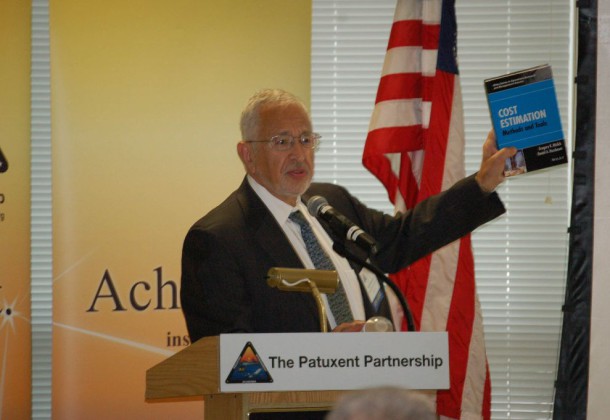Getting Paid for Getting it Wrong

If you’re looking for a new career twist, consider cost estimating. The “demand signal is good for awhile,” according to one of the first cost estimators to find the indispensable niche to government acquisition processes.
Cost estimating is both a science and an art. And regardless the balance, and regardless the skill of the estimator, there’s no guarantee the estimate will be anything close to correct. It’s one of the few jobs where you get paid whether you’re right or wrong. “You don’t know the future.”
And that’s what is required for cost estimating to be “right,” Dr. Daniel Nussbaum told more than 50 participants in The Patuxent Partnership briefing last month, “How to Improve the Acquisition & Cost Estimating Process,” at the Southern Maryland Higher Education Center. But “right” is not required for the cost estimate to be valuable.
Himself a cost estimator for DoD organizations, Dr. Nussbaum ran through the intricacies and nuances of acquisition processes and problems with the pacing of a stand-up comic, and at times with the punchlines as well. “People are forever trying to fix it,” he said of acquisition and cost estimating processes. Sen. John McCain’s efforts to return acquisition to the service chiefs is just a swing back from the Goldwater-Nichols legislation in the late 1980s that moved DoD acquisition back into civilian hands. “This is an old story,” he said.
Humor seemed almost a job requisite, because, Dr. Nussbaum told the crowd repeatedly, “there are lots and lots of problems” in trying to estimate a final cost of something, let alone something that is in the process of being invented.
The budget is different than a cost estimate, he emphasizes. But cost estimation is essential to it. Cost estimating is important for decisions involving budget allocations, affordability analyses, optimizations, and justifications for public policy. “The indispensables are data, people, training, risk and uncertainty,” he emphasized in a PowerPoint presentation accessible to TPP Members.
Cost estimating involves collecting data; normalizing the data to compare apples to apples and contemporary costs; and modeling the data into measurable projections.
The estimates are integral pieces of the cost benefit analyses included in every government decision, he said. It isn’t so much about getting the estimate “right,” but about having thoroughly researched, normalized and modeled factors to put into the cost/risk calculations. “We’re trying to get a reasonable story out there.” If the calculation proves wrong the estimate can be adjusted, factor by factor. “There is more than one answer. There is not one right, everything else wrong,” he said.
When a cost estimate on a new system goes wrong — and there are examples — that new data point becomes valuable, adding to a legacy of data for future estimates. Much of what is happening today carries no historic comparative data. “There’s no legacy” for brand new inventions. No one foresaw the internet, for example.
“Cost benefit analysis works,” concluded Dr. Nussbaum. “We are always tinkering with it. McCain will tinker with it again. We’re still tinkering.”























